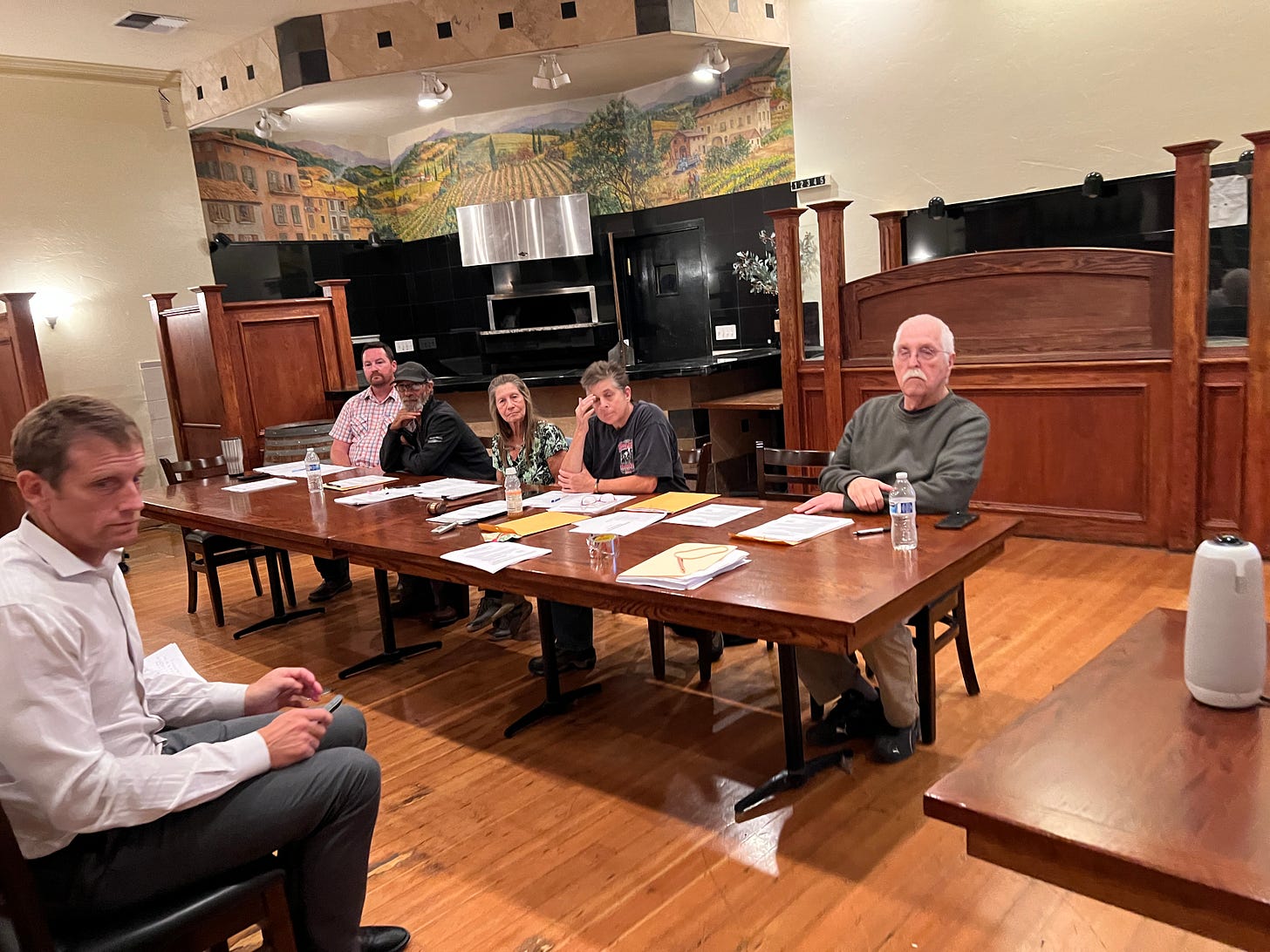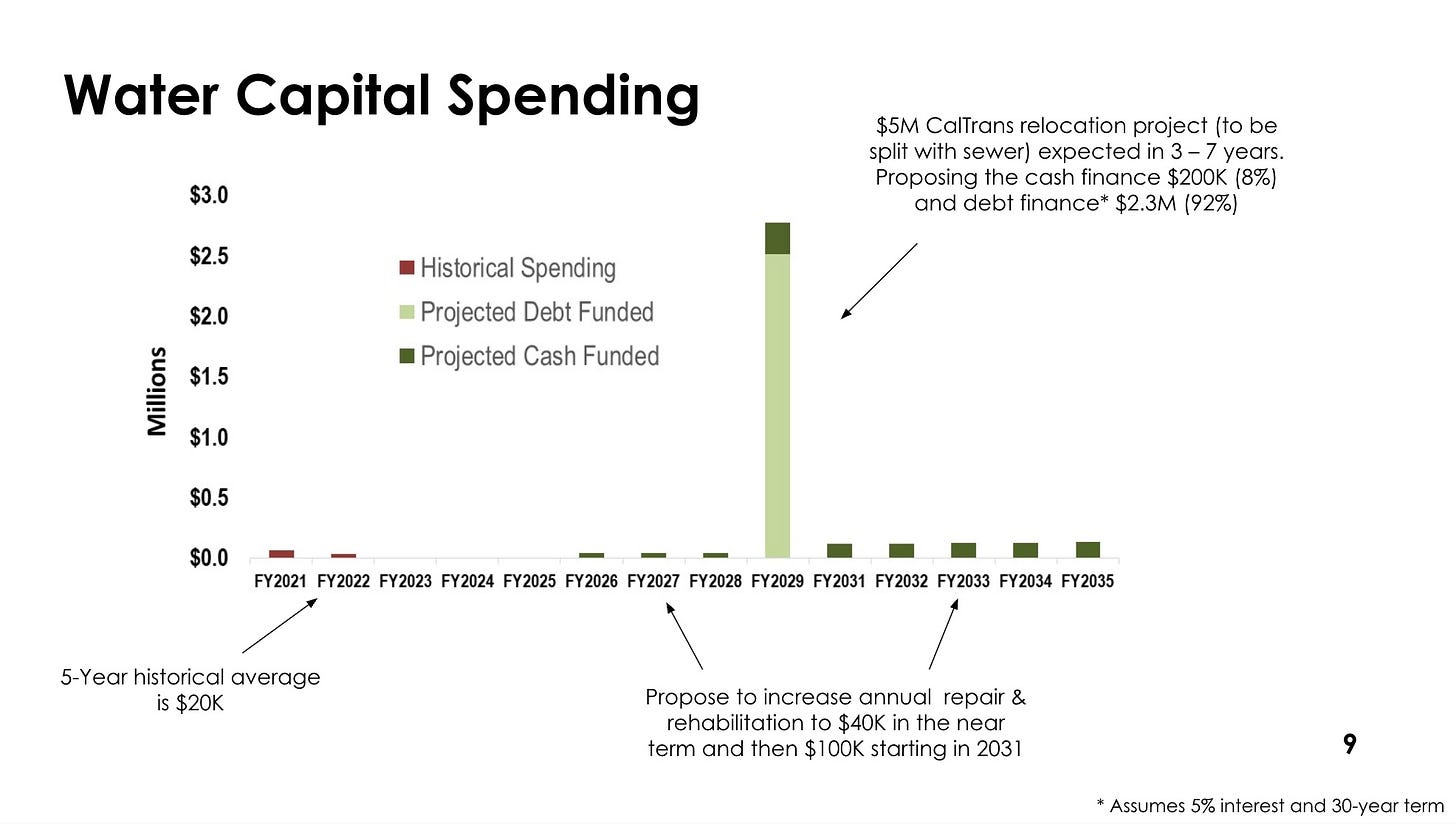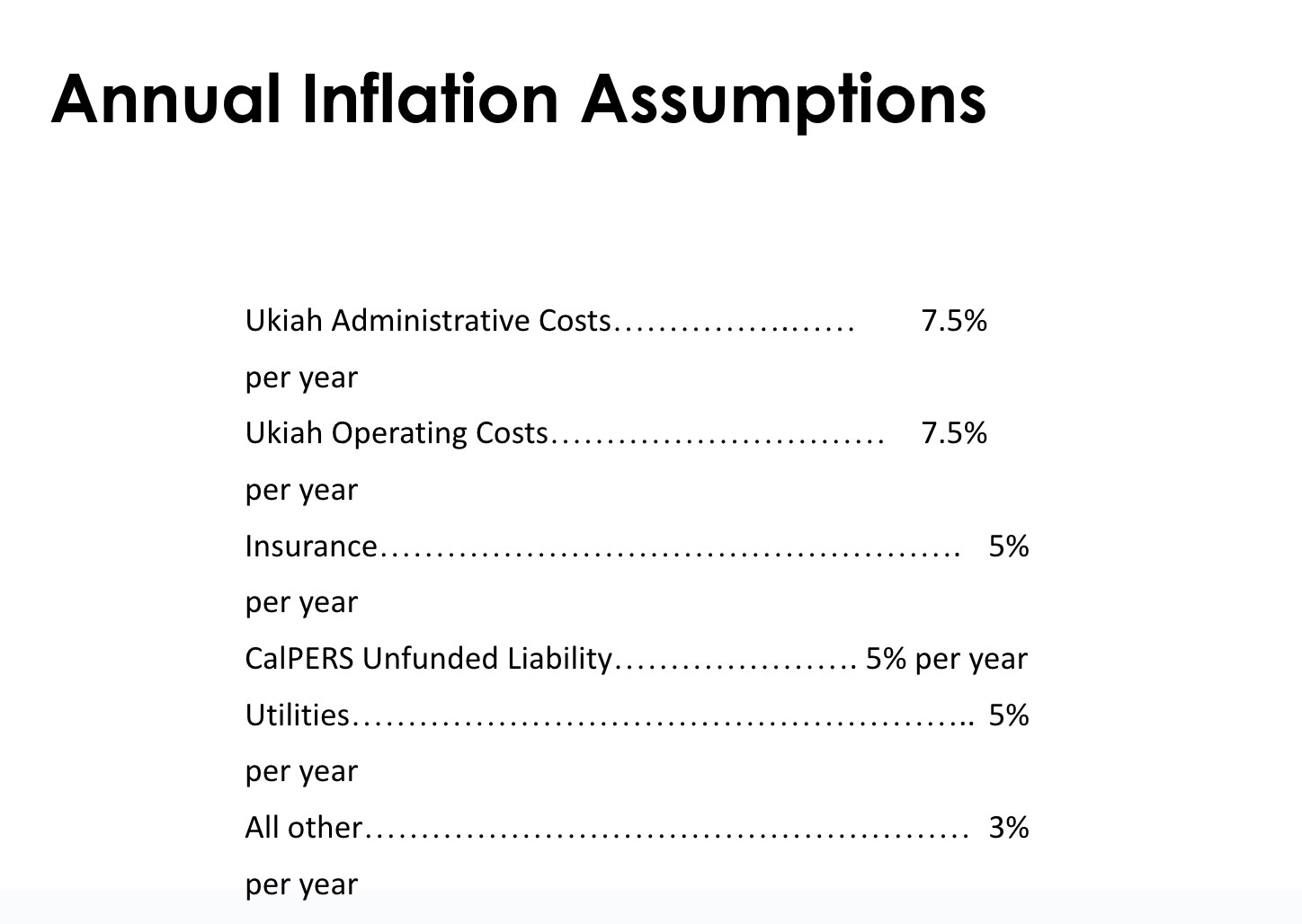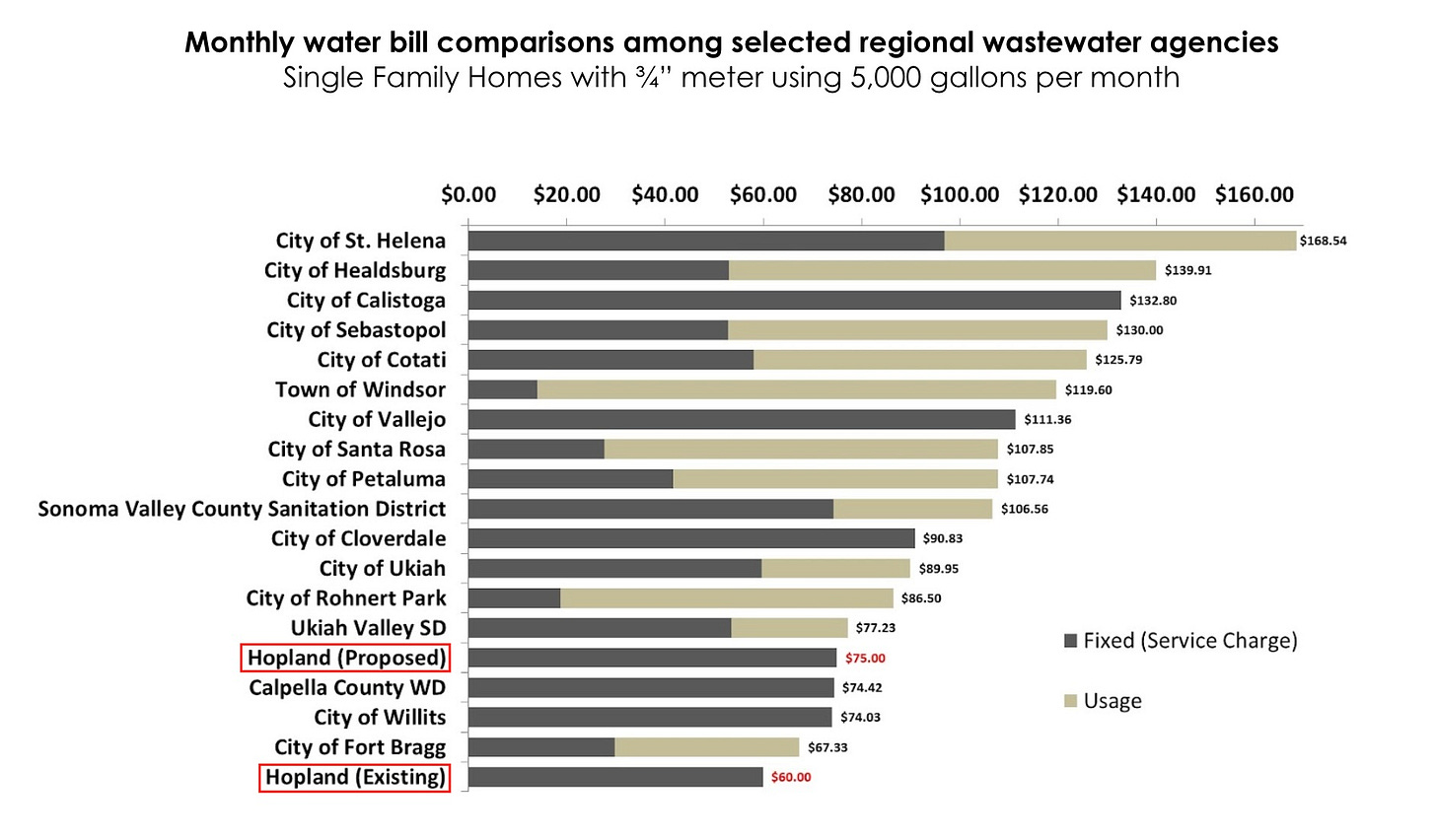Hopland Public Utility District Board Limits Public Comment, Votes to Triple Water Rates
Ratepayers express anger over lack of transparency, questionable justification

Editor’s Note: The story was updated with a link to the Water Measurement and Reporting Regulation, passed in June 2015, that authorizes the State Water Board to order the consolidation of water systems lacking adequate drinking water, particularly in disadvantaged communities. October 13, 2025
The Hopland Public Utility District board voted Thursday to sharply raise water and wastewater rates over the next decade, triggering confusion and anger among residents who questioned the accuracy of the district’s financial projections and the transparency of its process.
Under the new rates, the cost of water for roughly 330 customers will triple over 10 years, while the cost of sewer service will rise by at least 68 percent. The first round of increases — 40 percent for water and 25 percent for wastewater — will take effect Nov. 1. Additional hikes are scheduled for July 2026.
The board approved the increases after a contentious public hearing at Brutocao Cellars, where dozens of residents crowded into the room to demand explanations for the steep rate hikes. Many said they were frustrated by inconsistent figures, missing documentation and what they described as shifting justifications for the new charges.
Ratepayer Vernon Budinger called the hike “a smokescreen” to hide escalating administrative costs following a consolidation of outlying county water districts and the City of Ukiah. Budinger questioned the absence of standard cost estimates and requested a Class 3 or Class 5 engineering estimate — standardized estimate classifications defined by the Association for the Advancement of Cost Engineering (AACE International).
Board disputes level of opposition
At least one in three ratepayers submitted letters opposing the increases. Opponents argued they had reached the 50 percent protest threshold needed to block the hike under state law. The board disputed that claim, saying it found more than a score of duplicates.
An on-the-spot count during the meeting yielded 119 valid protest letters, or about 36 percent of ratepayers. But attendees contended that letters were not verified against the district’s official roster, and officials offered conflicting totals for the number of accounts — 330, according to Jared Walker, deputy director for water resources at the Ukiah Valley Water Authority, and 342, according to board members.
Cost Drivers in Dispute
Officials attributed the increases to years of underinvestment in the water system and to an anticipated Caltrans project on Highway 101 that could require the district to assume $5 million in new debt. No documentation for the Caltrans project was provided to the public at the meeting.
Earlier this year, Assemblymember Chris Rogers, who represents Mendocino County, introduced legislation that would have exempted the Hopland district from paying for utility line relocations tied to the project. The bill, AB 830, passed both chambers with overwhelming bipartisan support but was vetoed by Gov. Gavin Newsom on Oct. 3. (Two Democrats voted against the bill: Assemblymember Stephanie Nguyen from Elk Grove and Senator Eloise Gomez Reyes from San Bernardino.)
The project’s estimated cost, when discussed in the legislature was just $1 million — versus the $5 million that is being cited as required to relocate the water and sewer lines.
Limits on Public Comment
At the meeting, frustration over the lack of specifics about the CalTrans project and how utility line relocation could be required by the installation of flashing lights and culvert rehabilitation combined questionable limits placed on public comment.
Board member Joan Norry told the audience that the Brown Act — California’s open-meetings law — limited public comment to 10 minutes in total. In fact, the Brown Act imposes no such limit; local agencies may set reasonable time limits but generally must do so through publicly adopted policies versus ad hoc declarations.
Investing in Future Indebtedness
Financial consultant Mark Hildebrand, who was hired by the district to prepare the rate study, said the increases were needed to build a reserve of $100,000 a year for capital improvements and to support future borrowing. Without the Caltrans-related debt, he said, the 10-year compounded increase would have been about 167 percent.
“You have to establish a revenue base that can support the utility into the future,” Hildebrand said.
Consolidation and Administrative Costs
The Hopland district contracts with the Ukiah Valley Water Authority for management and operations. That relationship stems from the 2024 creation of the Ukiah Valley Water Authority, a joint powers authority formed by the consolidation of the Willow County Water District and other county water districts — a move that critics say has inflated administrative overhead.
Ukiah’s public employee salaries are high by Mendocino County standards, with department heads earning between $180,810 and $225,271 annually, according to city records. That’s between five and seven times the median income of Mendocino County.
Walker said the city provided a new service agreement in August 2025 that included an 11 percent increase in costs, after two years without rate adjustments. The agreement also built-in annual 7.5 percent cost escalations for services, effectively tying increases in administrative expenses to rate increases rather than actual inflation, which has risen by 7.5 percent only once in the last ten years (in 2022).
Unanswered Questions About Projects
When pressed for specifics on capital projects, Walker cited several priorities: lining a wastewater pond with concrete, repairing two leaking steel tanks, addressing groundwater intrusion that triples winter wastewater flows, and installing five new monitoring wells required by the North Coast Regional Water Quality Control Board.
“Those are four projects that we absolutely have to get done,” Walker said.
Still, residents said they were unconvinced that the such large increases were justified. “We’re not Sebastopol or Healdsburg,” said ratepayer Tina Moody. “The income isn’t here, the employers aren’t here, the money’s not here. Are you just willing to put everybody in the red?”
Hildebrand acknowledged that the Caltrans project might not proceed, but said the district was planning prudently. He said if the CalTrans project doesn’t happen — or if a new governor supports a bipartisan bill — Hildebrand maintained the rate increase could be reversed. Residents audibly expressed their doubt that would happen.
Budget Breakdown and Inflation Dispute
Administrative costs from Ukiah account for 29 percent of Hopland’s $276,000 water operating budget and 44 percent of its $181,000 wastewater budget. Existing debt service represents another third of the water budget.
Hildebrand told the audience that the Consumer Price Index had risen by 40 percent over the past decade, citing inflation as a key driver of costs. According to the U.S. Bureau of Labor Statistics, the actual increase for U.S. cities over that period was closer to 37 percent and averaged about 3 percent a year.
Hildebrand also displayed a chart comparing Hopland’s rates with those in Ukiah, Fort Bragg and Willits — the same presentation he used to justify a 36 percent increase in Ukiah’s rates earlier last month — that time, Ukiah was presented as having the lowest rates. This time Hopland ranked at the bottom.
“The Caltrans project will eventually become a one-time expense that hurt for a second,” Hildebrand said, before correcting himself. “It could hurt for a number of years.”
A Third Option
One resident suggested the district and resident compromise on a smaller rate increase. “I understand the need to raise rates,” said ratepayer Wendy Morelli. “But does it have to be a zero-sum game? Can’t we come up with something reasonable that everybody can live with?”
Walker said the Hopland Public Utility District could contract for a lower level of service with the Ukiah Valley Power Authority, but warned that if Hopland failed to maintain its system, the state could force a consolidation under SB 88, a water measurement and recording regulation that was passed in June 2015.
“I don’t think the community of Hopland wants to be governed by the state of California,” he said painting a picture of some might view as the worst-case scenario.
Read Mendo Local’s coverage of utility rate increases:






Wow. That’s great in depth material. You are the only reliable source of inland info since Justine retired. Good correction on the Brown Act. They can set a time limit but the act does not. Had to wonder how long the meeting went on. Trying to visualize the board checking the names at the meeting. Is any other media covering such a wild brouhaha? At least they picked a cool meeting spot